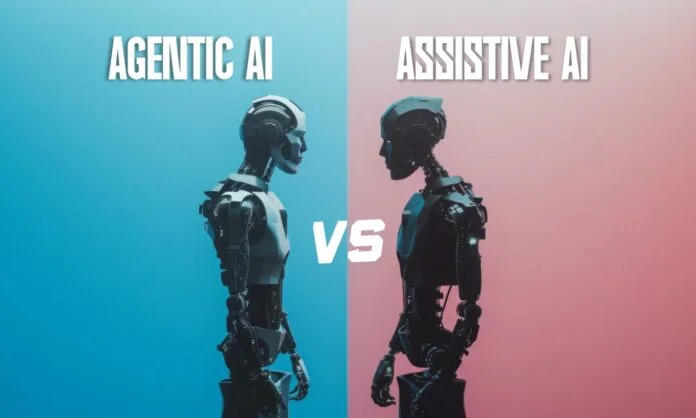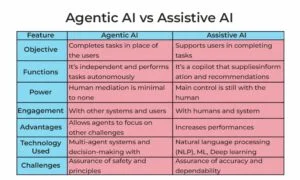Artificial intelligence improves with time; there come two different but correlating propositions in Agentic AI and Assistive AI.
Their basis of operation is similar as they both make use of Gen AI functionality while serving separate objectives in engaging with users and accomplishing jobs. As the name suggests, assistive AI helps humans with decision-making, while Agentic AI works on independent automation.
The main difference between them is that assistive AI is reactive and will perform tasks upon request, while agentic AI is proactive, working independently to accomplish the set goals by using all the necessary means.
In this blog, we will check out the differences between Agentic AI vs Assistive AI and their use cases.
What are Agentic AI and Assistive AI Actually?
This segregation into agentic AI vs assistive AI was recognized due to the expansion of AI technologies and their ideas.
The first one to come out of the two was assistive AI, addressing the issue of the expansion of human capabilities. The development of assistive AI was initiated due to the need to automate repetitive jobs, supply additional information, and assist people in making educated decisions. Early AI systems consisted of search engines, software for translations, and suggestions.
Agentic AI turned up later as things are created as per the needs of the time. AI technology attained a position where it was accepted that it can be passed on to more challenging jobs and provided with further independence. This was done due to the need to automate the entire process and not only the distinctive tasks. These systems could learn and adapt to the situations independently. Natural language processing, learning, and multi-agent approaches are linked with the development of agentic AI.
Understanding that AI can play distinctive roles in interaction with humans created agentic AI vs assistive AI. Agentic AI is seen as an autonomous performer that is competent enough to act on behalf of the user, and assistive AI is seen as a helping colleague.
Agentic AI vs Assistive AI: The Difference
They both utilize the power of Gen AI, but they have essentially separate roles in the way they engage with humans.
In the table, we have pointed out that Agentic AI vs Assistive AI have considerable differences that decide their advantages and applications. Assistive AI does a fantastic job at optimizing tasks and automating methods. Agentic AI unwraps the possibilities for building more independent and dynamic systems.
Although these two systems work separately, they are not incompatible. In everyday life, we can see that these two systems are working together. Agentic systems can also use assistive AI to tackle challenges.
Agentic AI vs Assistive AI: Use Cases
Customer Experience (CX)
Agentic AI takes CX and customer support far by adjusting to the user’s mannerisms instantaneously. In contrast to the assistive AI with pre-written answers, AI agents educate and update their engagement ways. They go through websites, applications, and IoT to build streamlined and extremely personalized UX.
AI assistants upgrade the CX by supplying instantaneous and real-world support through chats, voice, and email. They can manage queries from the customers, guide them through do-it-yourself options, and escalate challenging problems whenever required.
Human Resources
AI agents put HR automation forward by directing and optimizing talent additions, team engagement, and manpower planning. They filter candidates, book calendars for interviews, and improve hiring approaches by making use of previously stored data.
AI assistants support the organizations by easing the process of recruitment by creating job descriptions, categorizing resumes, and developing individualized messages. They also support admission procedures by guiding new employees with the organization’s policies, advantages, and training information.
Healthcare
AI agents help in making decisions in the healthcare field in challenging surroundings. In the emergency wards, a multi-agent system supports classifying patients while also altering the priorities depending upon the instantaneous data from the sensors. They also help in keeping the drug supply up to date by predicting inadequacies and can also alter the plans of treatment depending upon the response shown by the patient.
AI assistants respond to the patient’s questions in real-time, help in booking the appointments, billing, and provide access to the medical records. They also help doctors by outlining the histories of the patients and pointing out the priority cases. They can help in organizing documents for easier accessibility.
What Future Can Agentic AI and Assistive AI Hold?
Looking beyond the coming future, it offers even more inspiring opportunities, particularly in the development of assistive and agentic AI, even though 2025 promises to see considerable progress in AI. Trends like explainable AI (XAI), federated learning, edge AI, and other crucial elements will influence the development of these two important fields.
Businesses will be able to automate recurring jobs thanks to agentic AI, releasing human resources to focus on tactical projects and innovative problem-solving. Employees will be trained to use AI in novel and revolutionary ways because of this change, which will enhance productivity and encourage creativity.
The difference between Agentic AI and Assistive AI draws attention to the variety of ways that Gen AI is being used in today’s corporate environment. The shift to more autonomous, agentic roles as AI develops will surely influence the nature of work in the future, spurring increased adoption and opening new opportunities for companies everywhere.
Check out our blog section for all the latest tech news and trends!
Also Read:
What is Agentic AI? Key Benefits and Use Cases
Agentic AI: The New Trend Shaping Autonomous Decision-Making in the Tech World


